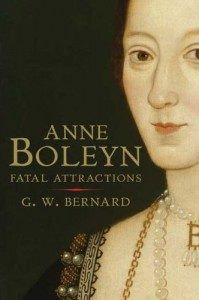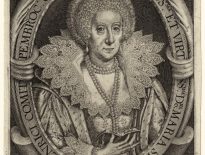
G W Bernard's book on Anne Boleyn
Born around 1502 in Bechworth, Surrey, Elizabeth was the daughter of Lucy Neville and Sir Anthony Browne; with the latter serving as standard-bearer to Henry VII and occupying the post of Lieutenant of Calais.
Little is known of Elizabeth’s early life, however, her family did have connections to the royal court. Her father was a trusted courtier, and in 1508 her sister Anne married Sir Charles Brandon, one of the future King Henry VIII’s closest friends.
During the 1520s Elizabeth was of marriageable age, and in around 1526 she was matched with Henry Somerset, the second Earl of Worcester. This was an elevated match as her father was neither royal nor noble, however, his descendants were members of parliament. Somerset’s first wife, Lady Margaret Courtney, granddaughter of Yorkist queen Elizabeth Woodville, had died without issue. Elizabeth and Henry married before 1527 and would go on to produce nine children, with many living into adulthood.
Lady Worcester, as she would now be called, is most famous for her role as lady-in-waiting to Henry VIII’s second wife and queen consort, Anne Boleyn. She served in the privy chamber and would have been in Anne’s company during her most private times, attending her both physically and emotionally. The role of lady-in-waiting was highly prestigious; having the queen’s ear informally in the privy chamber and receiving royal patronage was a convenient way of rising at court. Records suggest that Lady Worcester and Queen Anne had a close relationship, with the countess once borrowing some £100 from the queen - an incredible amount of money for the period - that she never repaid. Their friendship dates to before Anne’s rise to queenship, with records from the privy purse expenses of February 1530 revealing that Anne Boleyn had ‘rewarded the nurse and midwife of my lady Worcester’ after her delivery of a child, a demonstration of Anne’s kindness.
Although historiography has suggested a close friendship between mistress and lady, Worcester has been a source of discussion for decades; a debatable instrument in the downfall of Anne Boleyn. The queen had a considerable number of enemies at court, and her position as queen would not be without controversy and condemnation by the anti-Boleyn faction who viewed her as a usurper of Katherine of Aragon, Henry’s wife of twenty plus years. Upon her arrest and imprisonment in the Tower of London in May 1536, Anne Boleyn’s ladies, maids and attendants were questioned and interrogated regarding the accusations laid against Anne Boleyn, which included adultery, incest and plotting to kill the king. In a letter written by John Husse, the London agent of Lord and Lady Lisle in Calais, he states..’the first accusers, the Lady Worcester, and Nan Cobham, with one maid more. But the Lady Worcester was the first ground..’ Therefore, from this primary source, it can be suggested that Worcester was the first to turn on Anne and provide Cromwell and his agents with the information they desired for their investigation against the queen. This raises the question, why would Anne’s dearest and loyal friend testify against her? Historian G.W Bernard has suggested that Lady Worcester’s testimony may have had some truthful credibility, stating.. ‘she would have been aware of what was going on in the queen’s privy chamber, and might have been complicit to it.’ Bernard believes there was no reason for Anne’s ladies to fabricate the truth, and that if she was privy to Anne’s nocturnal activities, it made her an unlikely character to lie.
Elizabeth Somerset’s accusations are documented in a poem by the secretary to the French Ambassador to England, Lancelot de Carles. The poem, titled.. ‘A Letter containing the Criminal Charges laid against Queen Anne Boleyn of England’ was first printed in Lyons in 1545. The piece contained some well-known facts of Anne’s life, but controversially explains the accusations by Anne’s ladies. The poem states that a member of the privy council upbraided his sister for her loose and immoral living, with the sister retorting that the queen lived a far more sexualised life during her private periods and entertained gentlemen in her privy chamber at undue hours. Historian Muriel St Byrne has identified the sister and brother as Elizabeth Somerset and Anthony Browne. The countess, according to the poem, had spoken of Anne’s sexual relationship with her musician, Mark Smeateon, and her incestuous relationship with her brother, George. The version of events described in the poem tallies with the letters by John Husse, as mentioned earlier, who identified Lady Worcester as the first accuser of Anne’s supposed treasonous activities. Although evidence highly suggests Worcester as a primary player in Anne’s downfall, evidence from judge John Spelman, who presided over the trials of the men accused of having carnal relations with the queen, reveals that the matter of the queen’s immoral and treasonous activities was in fact disclosed by a woman named Lady Bridget Wingfield, a former attendant of the queen. According to Spelman Lady Wingfield disclosed the ongoings and loose living of the queen in her apartments on her deathbed in 1534. Due to the convenience of her death, she could not testify or be personally interrogated, resulting in her statement of accusations remaining incomplete.
During this tumultuous event, Anne Boleyn languished in the Tower in a state of uncertainty, not knowing what events would transpire and how her future would develop. The countess was expecting another child in the spring of 1536, and the warmth from her friend and former mistress was clear. Anne stated that.. ‘she much lamented my lady of Worcester..because that her child did not stir in her body.’ Elizabeth ultimately delivered a healthy child and named her daughter Anne. It has been suggested that this was in honour of the queen, however, this would be contradictory had Elizabeth been heavily involved in her mistress’s downfall and eventual execution.
Elizabeth Somerset died sometime in 1565, between when her will was dated in the April and when it was probated on 23 October. She is buried in Monmouthshire, Wales, and upon her death she left behind eight living children. Her reputation has been defamed through recent historical research, with most historians, including Eric Ives and Retha Warnicke, denouncing the poem by Lancelot de Carles as superficial and lacking in solid evidence.
Written by Alexander Taylor.



I went to visit the tomb of Lady Elizabeth Browne, Countess of Somerset and Worcester and her husband in Chepstow Abbey in June this year and it was quite odd, reading the paper article about Professor Bernard and his book. I don’t agree with his assessment that Anne must be guilty of something and Elizabeth ‘s evidence is very vague because it was recorded as being given via gossip. Lancelot de Carles makes a poem in which he says Lady Browne was confronted by her brother, Sir Anthony Browne and he accused her of extra marital behaviour and carrying another man’s child. Elizabeth, annoyed, refuted it saying so what he should hear what the Queen, that is Anne Boleyn gets up to. Anne she said was a right flirt. Browne reported the words of his wife to Cromwell and the King and this was included in evidence against Anne. Now we could dismiss all this as gossip save the trial reports name her as a witness or at least she was someone who gave evidence against Anne. The evidence was possibly no more than innocent observations, twisted to mean something in suspicious minds. Visiting the tomb was also weird as it is a very strange connection to Anne Boleyn, but somehow it was also as if there was something about the lady which said she has been misjudged by history. We don’t know the pressure Anne’s ladies were put under if they were asked about her activities. Mark Smeaton confessed to three times of sleeping with the Queen, after being pressured for 24 hours by Cromwell at his home. There are divided reports concerning torture, but as this was not common without a royal warrant it is more likely that the mere persistence of Cromwell and his questions, deprivation and fear made him confess. Even if the so called evidence of Elizabeth Browne is based on her careless remarks to her brother, it is something said in retort and annoyance and I am sure she certainly didn’t intend for her remarks to lead to Anne’s death.
You cannot believe a word of any of it. Cromwell was out to get what he wanted. My poor Anne…. I hope your soul can rest knowing we love you, dearly. No matter what happened, always remember that a Boleyn sat on the throne for the longest time. Non oif them won in the end..
Your dearest Sarah…
You cannot believe a word of any of it. Cromwell was out to get what he wanted. My poor Anne…. I hope your soul can rest knowing we love you, dearly. No matter what happened, always remember that a Boleyn sat on the throne for the longest time. Non of them won in the end..
Your dearest Sarah…
Please excuse the typo…